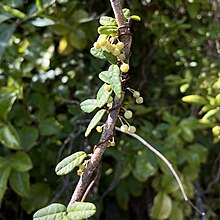
Back Boquila Catalan Boquila Spanish Boquila French Boquila Croatian Boquila Italian Boquila Portuguese Boquila Vietnamese
| Boquila | |
|---|---|

| |
| Scientific classification | |
| Kingdom: | Plantae |
| Clade: | Tracheophytes |
| Clade: | Angiosperms |
| Clade: | Eudicots |
| Order: | Ranunculales |
| Family: | Lardizabalaceae |
| Genus: | Boquila Decne. |
| Species: | B. trifoliolata
|
| Binomial name | |
| Boquila trifoliolata | |
| Synonyms[1] | |
| |
Boquila is a genus of flowering plants in the family Lardizabalaceae, endemic to temperate forests of central and southern Chile and Argentina. It is monotypic, being represented by the single species Boquila trifoliolata, locally known as voqui blanco or pilpil in its native range,[2] and sometimes referred as the chameleon vine since a recent report on leaf mimicry. The species was first described in 1782 by Juan Ignacio Molina, and the genus itself was established in 1839 by Joseph Decaisne. B. trifoliata forms non-parasitic vines that wind around host plants, using them for structure and protection. B. trifoliata is monoecious, and its flowers are an off white color. It bears an edible fruit and has been historically used in rope and basket making.
B. trifoliata is the only known plant species reported to engage in mimetic polymorphism, or the ability to mimic multiple host species, often simultaneously. This is a form of Batesian mimicry, when a harmless species mimics a harmful one to ward off predators. Contact between the vines and host trees was reported not to be necessary for mimicking to commence. However, after a decade of the original study describing the species mimicry capabilities in 2014, no independent research groups have verified the field observations and the mechanism by which this mimicry would occur is still unknown. Hypotheses about the mimicry mechanism include microbial mediated horizontal gene transfer, volatile organic compound sensing, and the use of eye-like structures.
- ^ "The Plant List: A Working List of All Plant Species". Archived from the original on May 24, 2019. Retrieved June 19, 2014.
- ^ "pilpil (Boquila trifoliolata)". iNaturalist. Retrieved March 22, 2024.